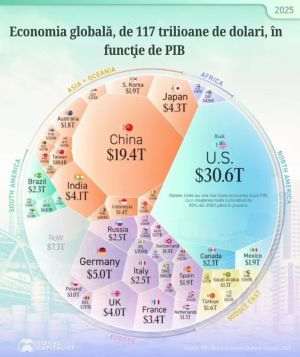The International Monetary Fund has tried to attenuate the pessimism reflected in its World Economic Outlook through the Global Financial Stability Report, titled "Potent policies for a successful normalization".
Without going too much into the psychological subtext of the title, a cursory read shows that the optimism of the Fund has no real basis, especially if we focus on the description of the financial situation of the financial system in Europe.
"The systemic risk is limited, but can grow all over Europe", the IMF document states, because there is "a confluence between the issue of non-performing loans and that of borrowing conditions", when the possibility of bail-in has been fully internalized by the holders of banking liabilities".
The euphemisms of the Fund are touching, especially if we look at the report on the global economic outlook.
Bloomberg writes that "the report is very pessimistic", amid "far too low growth that has lasted too long", according to the chief-economist of the institution, professor Maurice Obstfeld.
One of the risks mentioned in the introductory chapter of the report, is the return of the financial crisis, with negative effects on demand and confidence, about which it is stated that "they could enter a self-perpetuating negative feedback loop".
The choice of the term "self-perpetuating negative feedback loop" is extremely unfortunate for the specialists of an institution who should know something about dynamic economic systems. A negative feedback loop is by definition, stabilizing, whereas a positive feedback loop can lead to explosive growth or catastrophic growth.
In the opinion of the IMF, advanced economies are faced with the triple threat of low growth, low inflation and high public debt, and the recommended solution is, what else, a new quantitative and fiscal easing, the latter in the form of increased public spending on infrastructure projects. After all, elementary logic says that unsustainable public debt can be fixed by accumulating new debt, isn't it?
Vitor Gaspar, the head of the fiscal policies department of the IMF, told Bloomberg that "risks are higher than six months ago", and "the IMF is under alert, but not alarmed".
Perhaps the alarm has rung off in Washington, but in Europe the dashboard has an increasingly number of red lights, and most of them have lit up in the financial section.
Even the GFSR report of the IMF shows that "banks in Germany, Italy, Portugal and Spain are the most vulnerable to negative interest rates", whereas "banks in France, Holland, and Great Britain are better positioned", and "banks in the Northern countries have not been affected, because the deposits of the population have a low weight in the total liabilities".
The scope of the problems that affect banks in the Eurozone is also reflected by the evolution of the surplus liquidity, amid an increase of the value of deposits set up with the ECB, despite the negative interest.
The latest data shows that surplus liquidity in the banking system has reached approximately 750 billion Euros, 60 billion below the peak reached during the acute period of the sovereign debt crisis.
Why aren't banks in the Eurozone lending? Because they are faced with a significant capital deficit, the problem of non-performing loans is far from being resolved, and companies aren't asking for loans.
A recent study by the BIS - Bank for International Settlements has proved that there is a strong connection between the high level of capital, in its form of shareholder equity, without regulatory tricks and the volume of lending. In Europe, regulators have allowed banks to transfer about 400 billion Euros to shareholders, according to Bloomberg, in the form of dividends or stock buybacks.
On the other hand, European companies are significantly cutting their plans for capital expenditures, amid the negative growth outlook, also according to Bloomberg.
The major decline of the stocks of major German banks, in February 2016, together with the shares of banks in Greece, Italy and Portugal, is being blamed by the IMF on the structural problems caused by the capacity surplus, the high level of non-performing loans, as well as the flawed business models.
Legal costs, generated by the many lawsuits concerning market manipulation, also represent a great element of uncertainty, with highly negative effects for a European banking which has approximately 900 billion Euros in non-performing loans, according to the IMF estimates.
Of course, the unacceptable delay in acknowledging the lending losses, as well as the postponement of the radical restructuring process, have only been possible thanks to the ultrarelaxed monetary policy of the ECB and to quantitative easing. Now, negative interest rates and quantitative easing "are destroying those who save, the true foundation of capitalism", Bill Gross, fund manager at Janus Capital, told Barron's recently.
It was also Gross who recently wrote on the Janus Capital Twitter account, that the illusion of "confidence in the models of the central banks" will fall apart soon, together with trust that "negative yields are working".
The lack of trust in negative yields seems to have already crept in the GFSR of the IMF. It states that "markets and decision making factors do not have a historical basis for understanding the benefits and long term costs of low or negative interest rates".
As if the systemic risk generated by the major European banks wasn't enough, the project of a new memorandum between international lenders and Greece shows that "the country's debt is deeply unsustainable", according to Reuters, and "the canceling of part of that debt is essential".
But these things are of course known by everyone, except the European authorities do not want to take that step, because of all the charade of the last few years would be revealed. Moreover, the potential losses following the taking on of Greece's debts towards Western banks are turned into very real losses to the national budgets.
Amid the constant refusal of governments to release the market forces, in order to initiate true structural changes, the ECB remains, through its own money printing press, the only player that can prevent the overnight unraveling of the thin European weave.
To Steen Jakobsen, chief-economist of investment bank Saxo Bank, even this hope is vain, because "we are witnessing the end of central banks", as "the contribution of central banks to improving the situation in the markets has not just been exhausted, but has become negative".
What does the miracle expected by the European authorities look like, that is being invoked to turn the negative interest rates and the negative contribution of the ECB into something positive?

























































